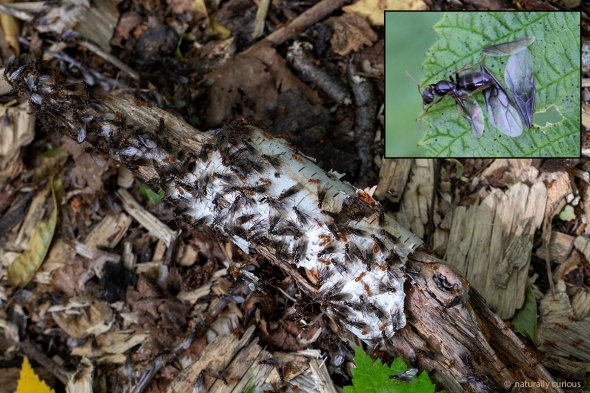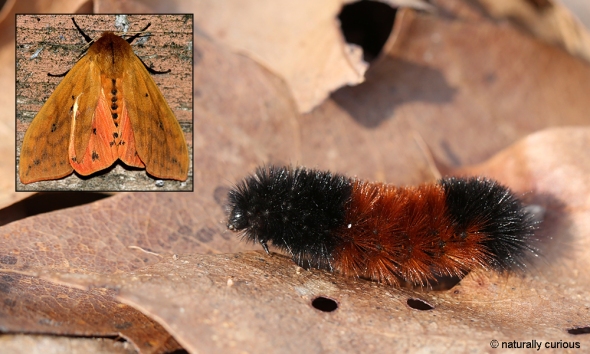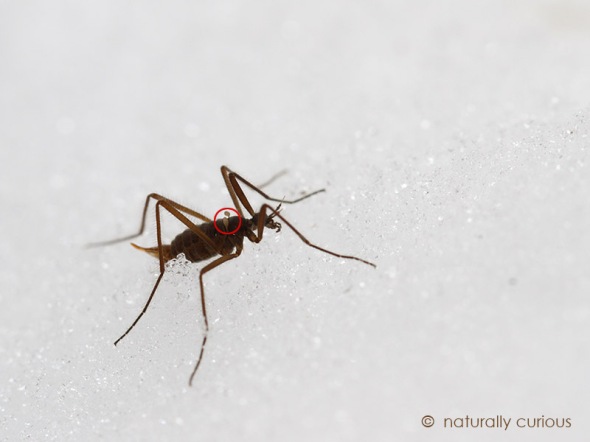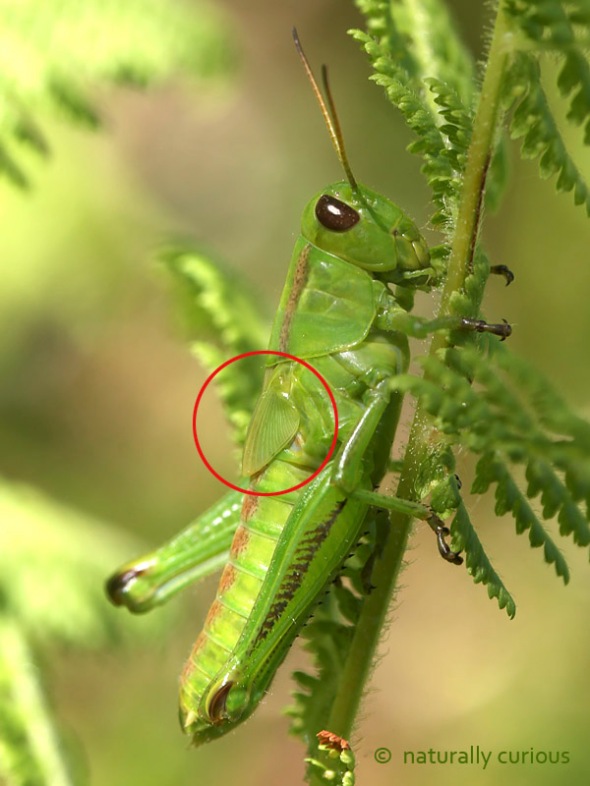Ant Queens & Males Swarming
 Ant colonies consist of one or more queens, female workers and males. In most species, only the males and queens have wings. Periodically the winged ants emerge from the colony in large swarms in order to mate. Swarming behavior is usually synchronized with other nearby colonies, so large numbers (hundreds or thousands) of winged ants suddenly appear. After mating, the males die and the queens chew their wings off and use the remaining wing muscles as a source of nutrients during the early stages of establishing a colony.
Ant colonies consist of one or more queens, female workers and males. In most species, only the males and queens have wings. Periodically the winged ants emerge from the colony in large swarms in order to mate. Swarming behavior is usually synchronized with other nearby colonies, so large numbers (hundreds or thousands) of winged ants suddenly appear. After mating, the males die and the queens chew their wings off and use the remaining wing muscles as a source of nutrients during the early stages of establishing a colony.
(Photo: A swarm of ants gathering as they emerge from their ground nest. The pictured (inset) ant has removed three of its four wings and is in the process of removing the fourth wing. Thanks to Alice Trageser for photo opportunity.)
Naturally Curious is supported by donations. If you choose to contribute, you may go to http://www.naturallycuriouswithmaryholland.wordpress.com and click on the yellow “donate” button. (NB: The “Donate” button on the Naturally Curious blog is currently not working. If you would like to donate to this blog, you may send a check made out to Mary Holland to me at 505 Wake Robin Drive, Shelburne, VT 05482.)
Woolly Bears Seeking Hibernacula

The Isabella Tiger Moth typically has two broods during the summer. The caterpillars (Woolly Bears) in the first brood pupate and emerge as adult moths mid-summer. The second brood overwinters as caterpillars and pupate in the spring. The Woolly Bears we see crossing roads at this time of year are second-brood caterpillars in search of protective hibernation sites (hibernacula).
Old-timers predicted the severity of the coming winter by the relative lengths of the black and brown bands of the caterpillars when they became easy to observe in the fall – the longer the black sections and narrower the brown section, the harder a winter they were in for. In fact, this may have had some validity, as brown hairs (setae) are added to the middle band every time the caterpillar molts. Therefore, the older the caterpillar, the wider the brown band. If winter comes early, the caterpillar’s brown band would be relatively narrow due to the fact it didn’t have time to mature fully and develop a wider brown section before hibernating.
The adult stage of the Isabella Tiger Moth is often overlooked, due to the appeal of the larval stage. This tan moth, with a wingspan of 1 ½ – 2 inches, has tiny black markings on its wings. Male and female are sexually dimorphic and can be distinguished by the color of their hind wings. Males have yellow-pale orange hind wings while the hind wings of females are rosy. (Photo: Woolly Bear; photo inset: female Isabella Tiger Moth)
Naturally Curious is supported by donations. If you choose to contribute, you may go to https://naturallycuriouswithmaryholland.wordpress.com and click on the yellow “donate” button.
The Emerald Euphoria Beetle: A Distinctive Scarab

Beetles comprise almost 40% of described insects and 25% of all known animal life-forms. There are about 30,000 beetles known as scarabs or scarab beetles in the family Scarabaeidae. They make up about 10% of all known beetles. You may be very familiar with scarab beetles without even being aware that that is what they are – they are as close as the nearest Japanese Beetle or June Bug (beetle).
Scarabs are generally oval-shaped and stout. The smallest are about .08 inches and the largest (Hercules beetles) can reach 6.7 inches. Most scarabs are black or brown, but many, especially tropical species, have bright colors and intricate patterns. They have distinctive, clubbed antennae composed of plates called lamellae that can be compressed into a ball or fanned out like leaves to sense odors (see photo). Their diet is extremely varied and includes plant material, fungi, fruit, carrion, insects and even the slime left by snails.
One fruit- and flower-eating species is the Emerald Euphoria beetle, Euphoria fulgida (pictured). It is usually bright green or bluish. Emerald Euphoria beetles belong to the subfamily Cetoniiae, the flower or fruit chafers. One of its most distinctive characteristics is its ability to fly (using its second pair of wings) while its first pair (the hardened, colorful elytra) remain closed — most beetles open and extend their elytra during flight.
Unlike most scarabs, Emerald Euphorias are diurnal, making it possible to see this species visiting flowers in order to consume nectar, pollen and petals. (Thanks to Richard Wyatt for photo op.)
Naturally Curious is supported by donations. If you choose to contribute, you may go to https://naturallycuriouswithmaryholland.wordpress.com and click on the yellow “donate” button.
Wingless Snow-walking Crane Flies
 Thanks to a sharp-eyed Naturally Curious blog reader, a recently mis-identified active winter insect can be correctly identified. What I referred to as a “snow scorpionfly” last week was, in fact, a type of crane fly that, as an adult, has no wings. Like snow scorpionflies, these wingless snow-walking crane flies appear on top of the snow on warm winter days. These two kinds of insects are also very similar in shape and size, but, unlike snow scorpionflies, this group of crane flies have what are called halteres, knobbed filaments which act as balancing organs (see photo).
Thanks to a sharp-eyed Naturally Curious blog reader, a recently mis-identified active winter insect can be correctly identified. What I referred to as a “snow scorpionfly” last week was, in fact, a type of crane fly that, as an adult, has no wings. Like snow scorpionflies, these wingless snow-walking crane flies appear on top of the snow on warm winter days. These two kinds of insects are also very similar in shape and size, but, unlike snow scorpionflies, this group of crane flies have what are called halteres, knobbed filaments which act as balancing organs (see photo).
Scorpion snowflies, despite their name, are not true flies in the order Diptera. Crane flies are. Most species of true flies have one pair of wings, instead of the usual two that winged insects have, as well as halters, which take the place of hind wings and vibrate during flight. While wingless snow-walking crane flies lack a pair of wings, they do possess halteres, which are the key to distinguishing between a wingless snow-walking crane fly and a snow scorpionfly, which lacks them! (Thanks to Jay Lehtinen for photo I.D.)
Naturally Curious is supported by donations. If you choose to contribute, you may go to http://www.naturallycuriouswithmaryholland.wordpress.com and click on the yellow “donate” button.
 Grasshoppers experience incomplete metamorphosis, with three life cycle stages – egg, nymph, and adult. A grasshopper egg hatches into a nymph, which resembles an adult grasshopper, except that it is smaller and lacks wings and reproductive organs. Because of its hard outer exoskeleton, a growing grasshopper has to shed its skin periodically to accommodate its increased size. (A larger exoskeleton develops beneath the old, smaller one that is shed.) Grasshopper nymphs molt several times (each stage between molts is referred to as an instar) before they reach their adult size, and with each molt, their “wing buds” get larger. After the final molt, the wings are inflated and become fully functional. Wings play an important part in grasshopper courtship, as males “sing” to attract females by rapidly rasping their leg against their forewing, a process called stridulation.
Grasshoppers experience incomplete metamorphosis, with three life cycle stages – egg, nymph, and adult. A grasshopper egg hatches into a nymph, which resembles an adult grasshopper, except that it is smaller and lacks wings and reproductive organs. Because of its hard outer exoskeleton, a growing grasshopper has to shed its skin periodically to accommodate its increased size. (A larger exoskeleton develops beneath the old, smaller one that is shed.) Grasshopper nymphs molt several times (each stage between molts is referred to as an instar) before they reach their adult size, and with each molt, their “wing buds” get larger. After the final molt, the wings are inflated and become fully functional. Wings play an important part in grasshopper courtship, as males “sing” to attract females by rapidly rasping their leg against their forewing, a process called stridulation.



















What Other Naturally Curious People Are Saying